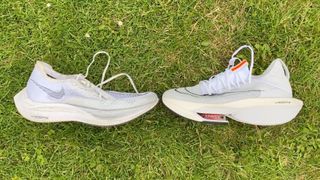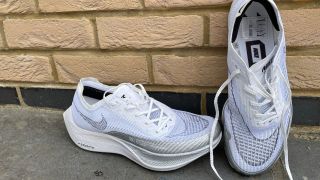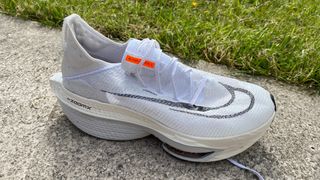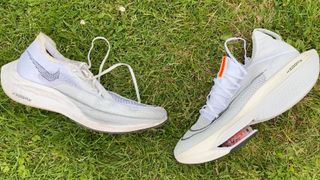Nike Air Zoom Alphafly NEXT% 2 Vs Nike ZoomX Vaporfly NEXT% 2: Nike’s Top Carbon Racers Compared
Nike’s carbon plate racers are the best in the business, but which of the Vaporfly and the Alphafly should you buy?

Nike created the modern carbon super-shoe with the launch of the original Vaporfly 4% in 2017. The latest generation is the Vaporfly NEXT% 2, which for many stands as the best carbon racing shoe.
Its stiffest competition in recent years has come from the Nike Air Zoom Alphafly NEXT%, which offers even more cushioning and is particularly good for marathons. Nike has now launched the Alphafly NEXT% 2, which has several updates on the original Alphafly that I consider to have improved the shoe.
- NEWS FLASH: The Nike Vaporfly 3 Will Launch On 6th March (13th February 2023)
Both are among the best running shoes available, but which Nike racer is best for you? Based on my reviews of both shoes, the answer might well depend on the distance and course you expect to be running.
Nike Air Zoom Alphafly NEXT% 2 vs Nike ZoomX Vaporfly NEXT% 2: Price And Availability
The Vaporfly 2 is widely available and costs from $225 in the US and £209.95 in the UK, with some colours and special editions of the shoe costing more. It’s also often available in sales. Nike has not confirmed the price of the Alphafly 2 ahead of its launch on 15th June, but I would expect it to be the same price as the original, which is $275/£259.95. Once again, some editions of the shoe cost more.
Design And Fit
The main change to the Vaporfly NEXT% 2 compared with the original Nike Vaporfly NEXT% was the new upper, made from a breathable mesh material. It has a reinforced section over the toes and a small amount of padding on the tongue and around the heel, but in general the upper is very minimal to keep the shoe’s weight down.

Nike also updated the upper on the second edition of the Alphafly NEXT% 2, which uses a knit material called Atomknit 2.0. It’s more structured and supportive than the Flyknit used in many Nike shoes, and on the Alphafly 2 the heel is built up to offer greater stability.
I found that both shoes fit me perfectly in my normal size, though the Alphafly 2 is not the easiest shoe to pull on since it has a bootie design rather than a separate tongue. It has pull tabs on the tongue and a collar to help you get your foot in.
Both shoes use Nike’s PEBA-based ZoomX foam in the midsole, but while the Vaporfly 2 has a full ZoomX midsole, with the foam running all the way through the shoe, the Alphafly 2 adds two Air Zoom pods under the forefoot. These have a slightly firmer feel than the foam alone, and provide a bit more pop in your toe-off. Both shoes also have a full-length carbon plate running through the midsole.
In the second edition of the Alphafly, Nike has added a sliver of ZoomX foam under the pods, and the shoe also has a wider base than its predecessor to improve stability, especially at the heel.

The two shoes have similar outsoles, with two strips of rubber running in parallel on the outsides of the back of the shoe and rubber covering the forefoot. There is a lot of exposed foam on both shoes, but the key impact zones are covered with rubber to improve grip and durability, though both shoes are clearly designed for road running alone.
Nike lists both shoes as having an 8mm drop from heel to toe, but doesn’t give official stack heights for them. The Alphafly 2 looks close to the 40mm limit set by World Athletics, while the Vaporfly is a millimetre or two lower.
The Alphafly is the heavier shoe. Nike lists it as weighing 8.8oz (249g) in a US 10/UK 9, though my two UK 9 shoes actually weighed different amounts at 8.6oz (244g) and 8.9oz (251g). The Vaporfly weighs 7.3oz (207g) in my UK 9.
Running Performance
The original Alphafly and Vaporfly 2 have been my go-to racing shoes in recent years: I prefer the Vaporfly for shorter events like 5K and 10K, and the Alphafly for half marathon and marathon distances. Both shoes have helped me log several PBs, including 15min 30sec over 5K in the Vaporfly 2 and 2hr 29min in the marathon in the Alphafly.
I’ve run 82km in the Alphafly 2 ahead of its launch, including a 20-mile (32km) long run, a parkrun, and two workouts with long spells at different race paces.
Although they use the same ZoomX foam and a carbon plate, the Vaporfly 2 and Alphafly 2 feel very different when running. The Vaporfly has a more aggressive feel, like it’s tipping you forwards, and it’s firmer underfoot as well. It’s more nimble than the Alphafly and makes it easier to attack corners at speed, thanks to its more grounded feel.
The Alphafly 2 is more of a cruiser, though no less fast. Whereas you know you’re running quickly in the Vaporfly 2, with the Alphafly 2 I was consistently surprised at the pace I was logging on runs given the perceived effort I was putting in. It’s a more comfortable shoe, and once you’re locked in to a certain pace it feels like it makes it easier to hold it.
While you don’t get tipped forwards so much in the Alphafly 2, it still feels like it’s delivering an efficient, energy-saving ride, and during and after long runs in the shoe my legs have felt very fresh.
The strengths of the Alphafly are maximised over longer races like the marathon, but it’s still a fantastic short-distance racer on the right course. By that I mean good roads (no potholes) and few turns. When you’re running in a straight line the weight and size of the shoe is more than offset by the bounce it offers, but when tackling turns the Alphafly 2 can be a little unwieldy. That’s especially the case at 5K or 10K pace, where the more agile Vaporfly 2 has the edge.
Verdict

While the Alphafly NEXT% 2 is an improvement on the original Alphafly, it has similar strengths and weaknesses, and I would suggest that it’s unlikely to win over many new converts from the Vaporfly NEXT% 2 if they preferred that shoe to the Alphafly.
The Alphafly NEXT% 2 is the perfect shoe for pounding through longer events, especially on city courses like Berlin and London where you have perfect roads and few turns. It’s also a great short-distance racer on the right course, but the Vaporfly’s lower weight and nimbler design does make it better suited to 5Ks and 10Ks in general.
Both shoes are excellent options for races of all distances, though, and with that in mind the Vaporfly 2 does offer better value. Not only is its RRP lower, it’s easy to find in sales these days, and if you can pick it up for $100/£100 less than the Alphafly 2, it’s hard to justify spending the extra on the Alphafly 2.
If you’re a dedicated marathoner, training for three or four months ahead of a big target race, the Alphafly 2’s price might not put you off. But if you have a variety of races on your calendar and just want a top-class racing shoe to tackle them all, the Vaporfly is the smarter pick.
- The best Nike running shoes for every type of runner
- Nike Vaporfly: Reviews of every generation and what makes the running shoe so special
Get the Coach Newsletter
Sign up for workout ideas, training advice, reviews of the latest gear and more.

Nick Harris-Fry is a journalist who has been covering health and fitness since 2015. Nick is an avid runner, covering 70-110km a week, which gives him ample opportunity to test a wide range of running shoes and running gear. He is also the chief tester for fitness trackers and running watches, treadmills and exercise bikes, and workout headphones.
